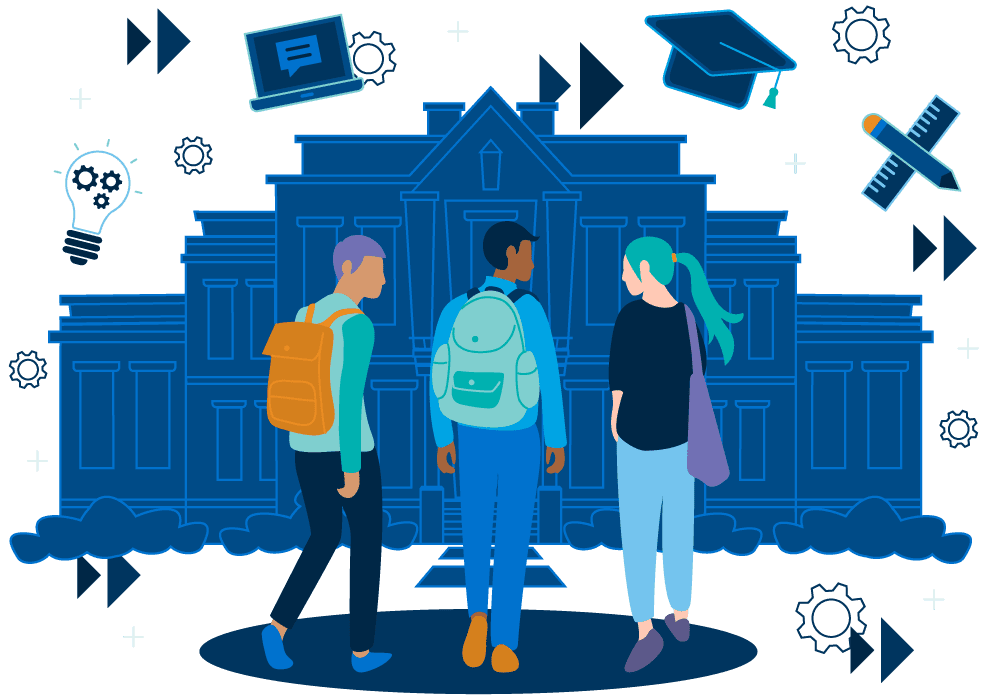How to support Black male student success
5 questions campus leaders should ask themselves
May 11, 2022

About this blog series
How do you see your students? And how do your students see themselves? “Identity” is a complex and dynamic concept, which varies widely from person to person and shifts over time, as the way in which we know ourselves and one another evolves and grows. As elusive as the concept may be, identity is an essential factor in student success strategy-there is no “one size fits all” method to supporting students and helping them achieve their goals. Institutions must understand their students’ backgrounds and lived experiences to provide support and guidance that fits their needs.
This series of blog posts explores identities shaped by circumstances, demographic factors, and individual-specific challenges and needs. Within these posts, we’ll discuss when recognizing and differentiating support around specific identifying characteristics can be helpful and when it can be harmful. We’ll also consider the intersectional nature of identity, and how schools and their staff can become more equity-minded as they work to better support each student they serve.
Previous posts in this series:
Black men face unique challenges in college. Many will have experienced inequities and structural hurdles throughout their education experience. When they start college, most find themselves in an isolating environment that is not only predominantly white, but also skewed female, especially within the Black community. Many will experience familial and financial commitments that continually threaten to pull them away from their studies. Others will lose connection with longtime friends from home who don’t share or understand the college experience. So it may come as no surprise that, in recent years, undergraduate enrollment among Black men decreased more than the decline seen across all students – a trend that is likely to be compounded in coming years by retention and graduation rates that are historically among the lowest of any demographic group.
15%
Decrease in undergraduate enrollment among Black men from fall 2019 to fall 2021, compared to an 8% decrease across all student during that time period, according to National Student Clearinghouse data
Despite these barriers, we know that more Black males will succeed when institutions provide intentional programming based on their histories, context, and needs. Many colleges and universities have African American Male Initiatives (AAMI) or Black Male Initiatives (BMI) specifically for this purpose. One outstanding example of an AAMI can be found under the leadership of Dr. Roderick Heath at North Carolina Central University (NCCU), an HBCU that is less than 30% male. Over 900 men have completed the AAMI program since 2009 and an astonishing 57% graduate within four years, 36 percentage points above the national average for Black students. In this post, I’ll share the questions Dr. Heath recommends any leader ask to improve their institution’s AAMI programming, as well as lessons on supporting Black male student success.
In brief: 5 questions leaders should ask themselves
To start, Dr. Heath suggests you ask yourself these questions about your AAMI programming to find opportunities for improvement:
- Is your work grounded in research that speaks to the Black male experience?
- Are you providing space(s) for students to build a brotherhood to ease the void felt from leaving home and others behind?
- Do you provide a supplemental curriculum focused on their socioemotional and academic needs?
- Do you provide and connect students to internships and mentors to improve post-graduate outcomes?
- Are you monitoring student trends in and outside the classroom to inform campus equity efforts?
3 ways to support Black male student success
1. Provide a holistic approach across the entire college journey
NCCU’s AAMI cohort programming bridges academic and co-curricular activities, including workshops and conferences covering identity, financial, academic, leadership, and spiritual development. Cross-campus staff engage in dialogue with these students about the range of feelings they experience throughout their time on campus. Support is intentionally baked into every year of their college journey. Black male students have the opportunity to be a part of all-male classrooms and have equitable access to tutors, coaches, peers, and support groups. The AAMI staff engages and supports student cohorts across key goals each year:
- Freshman: Transition to college life and fostering a sense of belongingness
- Sophomore: Learning from past mistakes and focusing on self-improvement
- Junior: Focus on professional development
- Senior: Articulate college knowledge to apply to graduate school or prepare for a career
“It must be a cross-departmental team effort. Work with colleagues across academic affairs, student affairs, residential life, counseling, and others. Ensure staff helps these Black men see their potential in a world where they would rather be entertained by than educate Black males.”
2. Put an intentional focus on social integration and mental health
One of the goals of NCCU’s AAMI is to support social integration and provide space for men to process acute or chronic trauma. Dr. Heath pairs incoming AAMI students with similar backgrounds or interests and gives students access to Black male role models. For example, over 70% of his Black male students are former high school athletes, a commonality he spotlights by inducting these students into the AAMI program, with a replica Hall of Fame jacket (pictured below). He encourages students to get their academic championship ring, and when they graduate, they get one. If students find themselves in a mental or academic crisis, they can access coaching sessions with Black male graduate students, often themselves former AAMI participants.

Working with colleagues in Residential Life, Dr. Heath created a four-year living-learning community. In its third year, it has become a place of academic achievement due to its outsized effect on improving students’ mental health. Students check in on each other, share notes, provide rides, and give each other some love when it’s been a rough day. AAMI staff will stop by to visit students they haven’t heard from in a while. And even without prompting from staff, these young men form study groups and book clubs and hold space for each other in ways others across the community could not.
What spurred the creation of a residential community?
When taking over the Men’s Achievement Center, Dr. Heath conducted a credit audit and found that a significant percentage of his juniors and seniors had started to struggle academically due to their decision to move off-campus. The goal of the four-year partnership was to keep Black male students from moving off campus after data showed a greater likelihood that off-campus students work more hours and focus less on academics. During the first year of the newly established living-learning community, the AAMI’s retention rate jumped from 71% to 90%.
Paired with supportive peers like the Latino Male Initiative (LMI), African Brother Alliance (ABA), and the Sisters of the Men’s Achievement Center (MAC), these programs provide an extra layer of support and personal belonging. As Jalen Spooner, an Academic Civic Engagement Coordinator at NCCU put it, “To stimulate students’ academic growth, it is important to place them in spaces where they can think freely and share their opinions with their peers. Including various groups such as AAMI, LMI, ABA, and MAC creates a space for a diverse group of students to share their views of the world.”
In addition to academic, social, and mental support, Sisters of the MAC enable these young men to create healthy platonic relationships, a skill that will serve them throughout their lives and careers.
Whitepaper: Improve Early Alerts with Equity-Based Communication
3. Help Black men prepare for life after college
Postsecondary success is no longer just about securing a degree; it’s also about obtaining that first job out of college. Here too Black men face alarming inequities. In response, Dr. Heath has built deep relationships across NCCU with alumni, community organizations, churches, and businesses to improve those outcomes for AAMI participants.
Yet for many of his AAMI students, life after college is about giving back because most did not benefit from having same race teachers. This reality is among the root causes of our national equity gap for children of color. With that in mind, Dr. Heath created the Marathon Teaching Institute (MTI) to increase the number of Black male school teachers in North Carolina. In a 2021 survey of graduated AAMI students, 63% were employed in their major, and nearly 20% obtained or are on their way to getting a graduate degree
A role for technology
Student success technologies can and should support the efforts of campuses to meet Black male students’ needs and enable institutions to collect and evaluate the data necessary to inform ongoing improvements that advance equity and success.
AAMI staff at NCCU use Navigate to meet students’ needs and address concerns and challenges in four ways:
- Use of advanced search, tags and student lists to monitor all AAMI participants and keep a closer eye on higher-support students
- Leverage faculty progress reports identifying students struggling with coursework and attendance
- Access data on student outreach, appointment rates, GPA, and credit hours for grant compliance reporting
- Analyze data to identify course trends that negatively impact GPA and use this to inform interventions
Regarding Navigate, Data & Administrative Coordinator Tyaisha Troy said, “Using Navigate is essential to our program. This data helps us collect immediate and valuable information that influences the types of programming we offer and the initiatives that we need to implement.”
What’s next?
Dr. Heath’s work at NCCU focuses on making sure success work is grounded in research, centering students’ experiences prior to entering higher ed and fostering belonging once they enroll, and monitoring initiatives to support continuous improvement. These principles apply to more than just specific AAMI and BMI programs. The same principles that make programs like NCCU’s successful should apply to any and all work your institution is undertaking to better support Black men. Only then will we be able to make meaningful national progress against declining enrollments and troubling graduation rates.
More Blogs

How to navigate policy challenges and show support for your trans students

Our LGBTQ students’ lives and wellbeing are at risk—here are 5 things campus leaders can do to help
